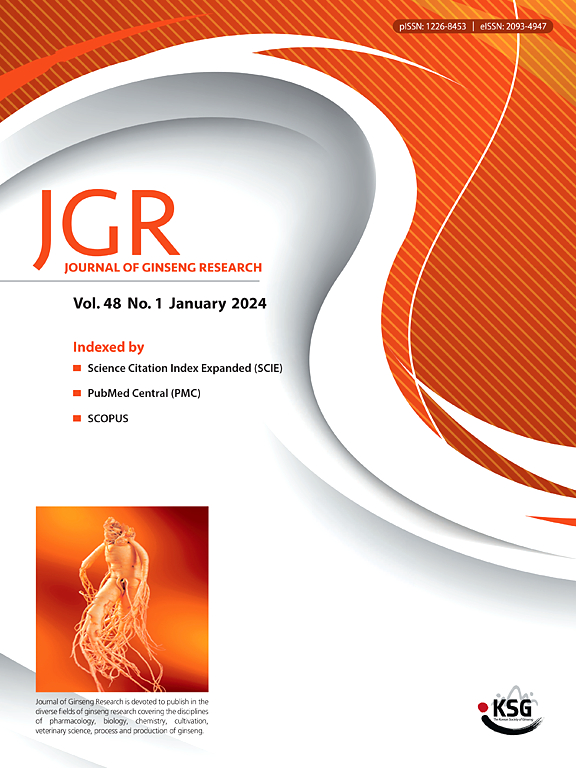人参皂苷Rb1和过氧化物还蛋白6通过抗炎、抗氧化和抗凋亡机制增强心肌损伤治疗的协同作用
IF 6.8
2区 医学
Q1 CHEMISTRY, MEDICINAL
引用次数: 0
摘要
aim人参皂苷在治疗心血管疾病方面具有显著的生物活性,但其与过氧化物还蛋白6 (PRDX6)联用治疗心肌损伤的机制尚不清楚。本研究探讨人参皂苷Rb1 (Gs-Rb1)与PRDX6的协同作用,旨在为其治疗潜力提供理论基础。方法建立异丙肾上腺素(ISO)致大鼠心肌损伤模型,通过心电监测和Masson染色观察,联合用药比单药治疗更有效。我们对联合治疗组和ISO组进行RNA测序(RNA- seq)。结果表明,与ISO组相比,联合治疗通过减少炎症、氧化应激和细胞凋亡来减轻心肌损伤。进一步的分析,包括细胞形态、凋亡率、HE染色、ROS荧光强度和炎症相关蛋白,证实了联合治疗成功地抑制了细胞凋亡,控制了氧化应激,减轻了炎症。结果Gs-Rb1和PRDX6联合用药可显著抑制大鼠心肌组织纤维化,显著降低血清CK和LDH水平。RNA-seq分析显示,与脂质代谢和小分子生物合成相关的基因上调,而与氧化应激、炎症和细胞凋亡相关的基因下调。验证实验证实了联合治疗对细胞凋亡、ROS活性和炎症的显著抑制。这些结果支持两种药物联合抑制心脏组织关键生物过程的有效性,提示对抗心脏纤维化的潜在机制。本研究阐明了Gs-Rb1和PRDX6如何共同保护心肌损伤,表明它们的联合治疗可以减少炎症、细胞凋亡和氧化应激。这为开发以人参为基础的治疗方法开辟了一条新途径。本文章由计算机程序翻译,如有差异,请以英文原文为准。
Synergistic effects of ginsenoside Rb1 and peroxiredoxin 6 in enhancing myocardial injury treatment through anti-inflammatory, anti-oxidative, and anti-apoptotic mechanisms
Aim
Ginsenosides have notable bioactivity in treating cardiovascular diseases, but the mechanisms of their combined use with Peroxiredoxin 6 (PRDX6) in myocardial injury remain unclear. This study explores the synergistic effects of Ginsenoside Rb1 (Gs-Rb1) and PRDX6, aiming to provide a theoretical foundation for their therapeutic potential.
Methods
We established a rat model of isoproterenol (ISO)-induced myocardial injury and observed that combination therapy was more effective than single-drug treatments, as shown by ECG monitoring and Masson staining. We performed RNA sequencing (RNA-Seq) on the combination therapy group and the ISO group. The results indicated that, compared to the ISO group, the combination therapy alleviated myocardial injury by reducing inflammation, oxidative stress, and apoptosis. Further analyses, including cell morphology, apoptosis rates, HE staining, ROS fluorescence intensity, and inflammation-related proteins, confirmed that the combination therapy successfully inhibited apoptosis, managed oxidative stress, and lessened inflammation.
Results
Combined treatment with Gs-Rb1 and PRDX6 significantly inhibited cardiac tissue fibrosis in rats, leading to a marked decrease in serum CK and LDH levels. RNA-seq analysis revealed upregulated genes related to lipid metabolism and small molecule biosynthesis, while downregulated genes were associated with oxidative stress, inflammation, and apoptosis. Validation experiments confirmed the combined treatment's significant inhibition of apoptosis, ROS activity, and inflammation. These results support the effectiveness of the two-drug combination in suppressing key biological processes in cardiac tissue, suggesting potential mechanisms for combating cardiac fibrosis.
Conclusion
This study clarifies how Gs-Rb1 and PRDX6 work together to protect against myocardial damage, demonstrating that their combined therapy reduces inflammation, apoptosis, and oxidative stress. This highlights a new avenue for developing ginseng-based treatments.
求助全文
通过发布文献求助,成功后即可免费获取论文全文。
去求助
来源期刊

Journal of Ginseng Research
CHEMISTRY, MEDICINAL-INTEGRATIVE & COMPLEMENTARY MEDICINE
CiteScore
11.40
自引率
9.50%
发文量
111
审稿时长
6-12 weeks
期刊介绍:
Journal of Ginseng Research (JGR) is an official, open access journal of the Korean Society of Ginseng and is the only international journal publishing scholarly reports on ginseng research in the world. The journal is a bimonthly peer-reviewed publication featuring high-quality studies related to basic, pre-clinical, and clinical researches on ginseng to reflect recent progresses in ginseng research.
JGR publishes papers, either experimental or theoretical, that advance our understanding of ginseng science, including plant sciences, biology, chemistry, pharmacology, toxicology, pharmacokinetics, veterinary medicine, biochemistry, manufacture, and clinical study of ginseng since 1976. It also includes the new paradigm of integrative research, covering alternative medicinal approaches. Article types considered for publication include review articles, original research articles, and brief reports.
JGR helps researchers to understand mechanisms for traditional efficacy of ginseng and to put their clinical evidence together. It provides balanced information on basic science and clinical applications to researchers, manufacturers, practitioners, teachers, scholars, and medical doctors.
 求助内容:
求助内容: 应助结果提醒方式:
应助结果提醒方式:


